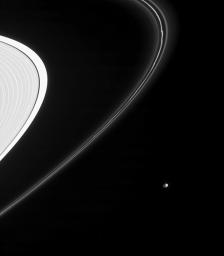Bruce Moomaw has a pretty length post over at the Unmanned Spaceflight.com forum covering some confusion regarding the Cosmic Dust Analyzer (CDA) results from the Enceladus flyby last month. The confusion results from whether the particles seen by the CDA instrument were in fact from impact-generated dust, or from a south polar plume. Early analysis suggested that the particles came from impact-generated dust rather than the south polar "plume" since the dust appeared to be uniform over the surface while the atmosphere/plume is not. Emily Lakdawalla, from the Planetary Society,
posted an article a week or so ago describing the results, using information from the press release and an interview with Linda Spilker, the Cassini Deputy Project Scientist. In the article, Lakdawalla quoted Spilker as saying that the dust seen by the CDA instrument (the dust near Enceladus and the E-ring) were different from the water vapor seen by UVIS, INMS, and MAG, and that the south polar vents were not the source of the E-ring. However, as Bruce mentioned in a comment here, if the E-ring was generated solely by impacts on Enceladus, wouldn't other moons like Mimas have the same sort of impact-generated ring co-orbiting with the satellite.. So Bruce did a little digging and talked with Spilker. Turns out that Lakdawalla quoted her incorrectly. The difference between the CDA dust and the atmosphere seen by UVIS et al. is that the CDA saw water particles and UVIS et al. saw water vapor, nothing more.
In addition, Bruce dug up a new tidbit. Previously, the CDA team has been reporting that the dust was uniform across the surface (leading to the conclusion that the particles didn't have a localized source). Even if the particles were formed by condensing water vapor from the vent, there would be some sort of asymmetry in the CDA data biased to the south polar region. Turns out that the CDA may have seen an asymmetry in the amount of dust with respect to location over Enceladus. This is a very intriguing development and may indicate that the particles near Enceladus and perhaps the E-ring itself were formed from condensing particles from vents in the south polar region.

 N) based on laboratory infrared data
N) based on laboratory infrared data
